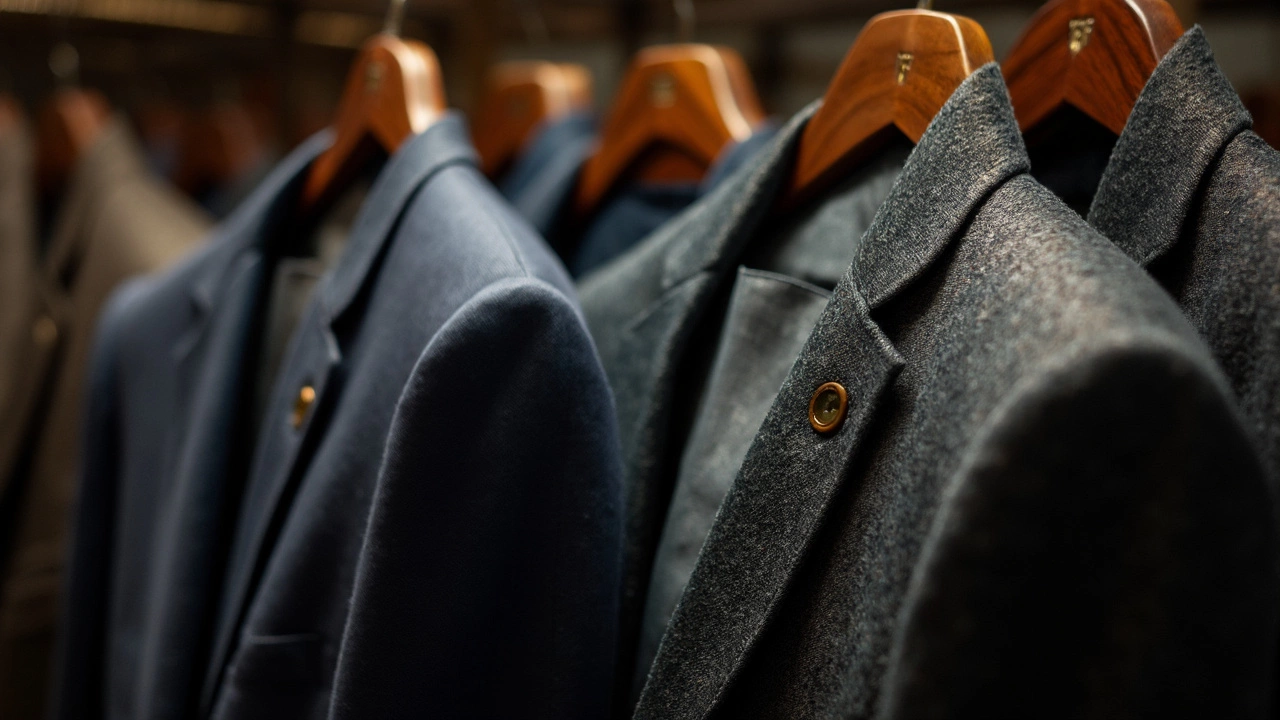You can spot a cheap suit without even touching it, if you know the tricks. Think about the last time you saw a suit that just looked... off. Maybe it shined in a weird way or felt stiff instead of smooth. That’s often the fabric giving the game away. Most cheap suits use polyester or blends that look sort of plastic under the light. An expensive suit? Wool is king here—sometimes you’ll see cashmere or silk woven in. Those natural fibers drape better and feel way softer on your skin. Try this: scrunch the sleeve in your fist and let go. Cheap fabric stays wrinkled; quality wool bounces right back.
It's not just what you see—it's what you feel. Expensive suits actually get more comfortable the longer you wear them. Cheap ones? They might start to itch or heat up like a sauna. You don't need a magnifying glass or a fashion degree. Just train your eyes and hands for a few simple clues, and you'll spot the difference in seconds.
- Fabric and Texture
- Stitching and Construction
- The Importance of Fit
- Details: Buttons, Linings, and Labels
- Value vs. Price: Paying for Quality
Fabric and Texture
The fabric is the biggest giveaway when figuring out if a suit is cheap or expensive. It's really all about touch, look, and even the way the material moves. Most expensive suits use pure wool—often "super 100s" or higher, which just means a finer, softer fiber. You might see extras like cashmere or silk for a super-luxe feel. Cheap or entry-level men's suits, on the other hand, often use a polyester blend or synthetic fibers to cut costs. Yes, it’s easier to care for, but it never drapes as naturally and usually feels stiff right out of the box.
If you run your hand over a good wool suit, it’s smooth and sort of springy. It doesn’t shine under harsh light (that plastic-looking shine is classic polyester). Compare that to a bargain suit at a big-box store—the fabric might actually squeak or feel rough. Here’s a simple test: bunch up the fabric in your fist and let go. Cheap suits wrinkle, keep creases, and sometimes even hold static. Expensive suits bounce back almost perfectly, thanks to the natural "memory" of wool.
There’s one more trick: check the weight. High-quality suits have a certain heft—nothing crazy, but they don’t feel flimsy. That weight helps the jacket keep its shape and hang properly. Lighter, thinner materials tend to hug awkwardly and show every wrinkle or bump underneath.
- Avoid shiny material unless it says it's silk. Most shiny suits are loaded with polyester.
- If you're unsure, check the label. If wool isn’t the main ingredient, it’s probably a cheap suit.
- Look for words like "Super 100s" or "Super 120s" on the label. The higher the number, the softer and finer the wool.
Fun fact: The average lifespan of a good-quality wool suit is 5-10 years if you take care of it, compared to about 1-2 years for a suit packed with synthetics. That’s money well spent in the long run.
Stitching and Construction
If you’re staring at racks of men's suits, the stitching and construction are like flashing neon signs telling you what's cheap and what’s worth your money. First, check the seams—expensive suits almost always use something called a "full canvas" or at least a "half canvas" inside the jacket. This makes them hang better and last longer, while cheaper suits use glue (fusing), which eventually bubbles and peels, making it painfully obvious the suit was a budget pick.
Grab the lapel and pinch the fabric—can you feel a soft layer in between? That’s canvassing and it’s a quick way to tell you’re holding quality. Next, run your finger along the seams inside the jacket. If the stitches are tiny, even, and barely visible, that's a win. If they’re big or loose, it's a red flag.
For more clues, peek at the way the lining attaches. On a good suit, the lining is hand-stitched (so you might catch little, almost-invisible pick stitches). Mass-produced cheap suits usually have machine stitching that’s thick and stands out. Even buttonholes tell a story: real buttonholes (called "surgeon’s cuffs") at the wrist mean time and effort went into making it. On a cheap suit, those buttons are sewn straight onto the fabric and often don’t open.
- High-end suits: Full/half canvas inside, hand-finished stitches, working buttonholes
- Low-end suits: Fused glue in construction, big/uneven stitches, fake buttonholes
Research from fashion industry groups shows that jackets with proper canvas construction can last up to three times longer than glued ones—not a small detail if you’re spending serious cash. Want a suit that looks sharp for years? Focus on the build, not just the label.

The Importance of Fit
Here’s the thing: no matter how much you spend, if a suit doesn’t fit you right, it just looks wrong. A cheap suit with a perfect fit can even outshine a pricey one that hangs off your shoulders. That's why pros always say the fit is half the battle when it comes to men's suits.
Fit isn’t about just grabbing your size from a rack. Off-the-rack suits are usually made to fit as many people as possible, so they end up being baggy in places or tight in others. Higher-end—or even mid-range—suits are usually adjusted by a tailor. A well-fitting jacket should hug your shoulders, not slouch over them. The sleeves should end just at your wrist bone, letting about half an inch of your shirt cuff show. If you raise your arms and the whole jacket rides up, that’s a dead giveaway the fit’s off.
Pants matter just as much. You shouldn’t get a giant puddle of fabric at your shoes, or pants so tight they pull across your thighs. Most quality tailoring has the hem right at the top of your shoes with a gentle break. And don’t forget: the suit should be comfortable when you move around, sit, or reach forward. Never buy a suit without moving in it first—you’ll regret it every time you have to pick something off the floor at a wedding.
- Expensive suits often come with unfinished hems on the pants, so you can get them tailored to your ideal length.
- Cheap suits usually stick with a defined "standard" size, and the fit is more forgiving for the manufacturer than the buyer.
- Custom and made-to-measure options are becoming more popular, letting you adjust everything from the chest size to armhole height.
If you care about how you look, always budget for tailoring—even a small adjustment can make a huge difference on a budget suit. According to a survey by Business Insider, 78% of people thought someone in a fitted suit looked more successful, even compared to someone in an expensive but ill-fitting suit.
Details: Buttons, Linings, and Labels
If you want to pick out a cheap suit from an expensive suit in seconds, pay close attention to the buttons, linings, and even the label sewn inside. These details reveal more than you’d think.
Let’s start with buttons. Most cheap suits use basic plastic buttons that feel light or flimsy. Sometimes you’ll spot loose threads or buttons that don’t even match each other perfectly. High-end suits use real horn, corozo (a natural nut), or even mother-of-pearl for special editions. Grab the button—does it feel cool and solid? That’s a good sign of quality. And check how it’s sewn: cross-stitched buttons, or ones sewn with a shank (a little stem under the button), are common on expensive suits and help the button hold up over years of use.
Linings are another giveaway. In men's suits at the low end, you’ll find polyester linings which make you sweat and sometimes even squeak when you move. Good suits (think custom or high-end off-the-rack) almost always have Bemberg or cupro linings—smooth and breathable, making the jacket feel lighter and comfier. Some top brands even go half-lined or unlined to show off neat interior stitching and keep things airy. If you peek inside and see sloppy, puckered stitching or feel stiff, sticky lining, you’re dealing with a budget suit.
Labels don’t just tell you the brand—they’re clues about quality. Most luxury suit labels are stitched in with clean, even lines and sometimes even have a numbered series or "made in" tag that tells you where it came from (think “Made in Italy” or “Savile Row, London”). Cheap suits sometimes have glued or heat-pressed labels, or generic phrases like "Designed in Italy" but made elsewhere. That’s not a death sentence, but it can signal shortcuts.
- Good suits use real horn or corozo buttons, cheap suits use plastic.
- Look for smooth and breathable linings (like Bemberg or cupro), not clammy polyester.
- Labels stitched in with care usually reflect higher suit quality.
| Detail | Cheap Suit | Expensive Suit |
|---|---|---|
| Buttons | Plastic, loose, mismatched | Horn, corozo, sewn with shank |
| Lining | Polyester, stiff, hot | Bemberg, cupro, half- or unlined |
| Label | Glued, generic, uneven | Neatly stitched, "Made in" tag, serial number |
It’s amazing how these little things—buttons, linings, and labels—can make all the difference in how a men's suit feels and lasts. Always give them a close look before making a decision.

Value vs. Price: Paying for Quality
The sticker price on a men's suit doesn't always tell you its true value. A suit might cost a lot because it's got a well-known logo, but that doesn’t always equal better quality. What really matters is how it’s made, how it fits you, and what it feels like after a few months—not just the hype.
It helps to break down what you’re actually getting for your money. Cheap suits usually cut corners on the fabric, construction, and even the little details like buttons. High-quality, expensive suits use better materials—think 100% wool, real horn buttons, and full canvas construction. These upgrades aren’t just fancy terms; they add up to a suit that keeps its shape, breathes well, and lasts a lot longer. In fact, a decent quality suit, with a little care, can survive in your closet for 10 years or more—far outlasting a cheap one that starts falling apart after a couple of dry cleans.
Here’s another angle: cost-per-wear. If you grab a $200 suit and it looks worn out in a year, that’s $200 down the drain. But if you drop $1,000 on a suit that you wear once a week for ten years, do the math—it costs less per wear, and probably makes you feel way more confident every single time. Here’s a simple comparison:
| Suit Type | Initial Cost | Average Lifespan | Cost Per Wear (Once/Week, 5 Years) |
|---|---|---|---|
| Cheap (Polyester Blend) | $200 | 1-2 years | $2 |
| Expensive (Wool, Full Canvas) | $1,000 | 5-10 years | $0.38 |
Another thing to think about is tailoring. Expensive suits are cut with more fabric in the seams—meaning they can be adjusted to fit your body as it changes over time. Cheap ones don’t give you this wiggle room, so if your size changes even a little, you’re out of luck. Smart buyers pay attention to the little things that make a suit feel just right: soft linings, smooth zippers, and neat stitching. These cost more upfront, but you’ll see and feel the difference every time you put it on.
Don’t just chase the lowest price. Track where your money’s going and what you’re really getting back. Good quality in a men's suit is an investment—it pays off with durability, comfort, and style that lasts way longer than any fast fashion deal. Think long-term, not just next month’s event.

